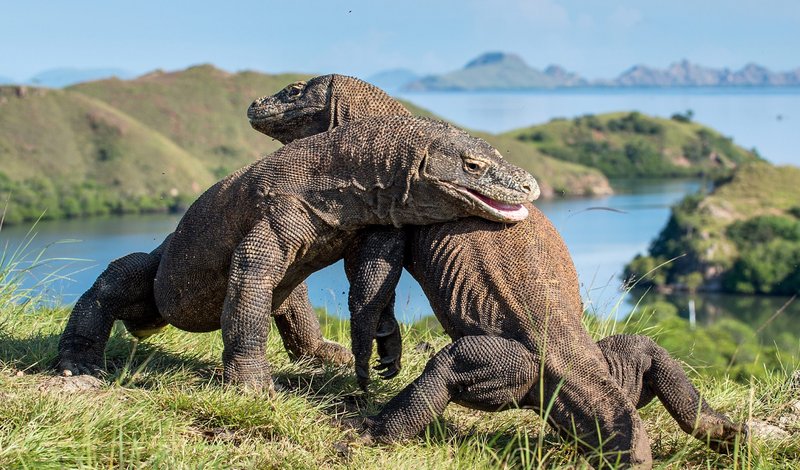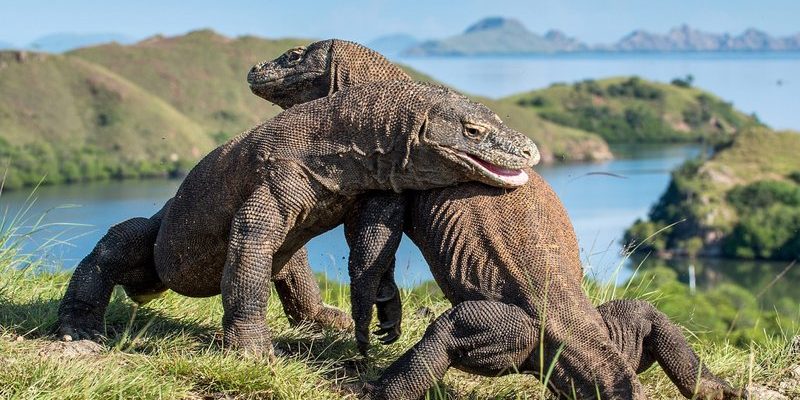
When you think of dinosaurs, you may picture massive scales and sharp teeth. Well, the Komodo dragon is often referred to as a “living dinosaur” because of its size and ancient lineage. These magnificent reptiles not only dominate their habitats but also have unique traits that set them apart in the animal kingdom. So grab your coffee, and let’s explore the incredible life of the Komodo dragon!
1. They’re the Largest Lizards on Earth
When we talk about size, the Komodo dragon takes the cake. These lizards can reach lengths of up to 10 feet and weigh as much as 150 pounds or more! That’s roughly the size of a small motorcycle. Imagine running into one of these guys during a hike—talk about a jaw-dropping experience! Their size isn’t just for show, though. Being the biggest lizard on the planet gives them a significant edge in hunting and survival.
Besides their impressive length, Komodo dragons have incredibly muscular bodies, strong jaws, and sharp claws. These features allow them to tackle prey much larger than themselves. Whether they’re ambushing a deer or scavenging for carrion, their size plays a crucial role in their hunting tactics. And if you think size doesn’t matter in the wild, think again!
2. They Have a Unique Hunting Strategy
What’s intriguing about the Komodo dragon is how they approach hunting. Rather than relying solely on speed, they use stealth and patience. Let me explain: Komodo dragons often lie in wait for hours, camouflaged in their surroundings, before striking. Once they spot their target, they can sprint up to 13 miles per hour for short bursts. That’s like the speed of a quick sprinting dog!
After a successful bite, things get even more interesting. You see, their saliva contains a mix of bacteria that can infect their prey. This means that even if a Komodo dragon doesn’t kill its target instantly, the bacteria can lead to a slow death. It’s like a survival tactic that allows them to scavenge later when the prey is weakened. Nature is brutal but fascinating, isn’t it?
3. Their Tongue is a Super Sniffer
Did you know the Komodo dragon’s tongue is more than just a tool for tasting food? Their long, forked tongue can pick up scents from the air, helping them track down prey from over five miles away! Just like how we might use our nose to smell something delicious cooking, these lizards use their tongues to gather information about their environment.
When they flick their tongues, they’re tasting the air and getting a sense of what’s around them. If they smell something interesting, they’ll follow the scent trail. It’s a brilliant survival mechanism that shows how the Komodo dragon has adapted to its environment over millions of years. Talk about having a nose for lunch!
4. They Have a Powerful Bite
A Komodo dragon’s bite is no joke! Their sharp teeth resemble those of a shark, designed to tear through flesh. But what makes their bite so deadly isn’t just their teeth; it’s also the bacteria present in their mouths. Scientists have found over 50 types of bacteria in their saliva, which can cause severe infections in their prey.
When a Komodo dragon bites its target, the bacteria enter the wound and can lead to sepsis—this is why that slow-killing strategy works so well. It’s like nature’s version of a stealthy assassination! And here’s the kicker: the dragons are largely unaffected by these bacteria themselves, showcasing their remarkable adaptation.
5. They Can’t Regulate Their Body Temperature
Unlike mammals, Komodo dragons are ectothermic, which means they rely on the environment to regulate their body temperature. In simpler terms, they can’t produce their own body heat but depend on the sun to warm up. This is why you’ll often find them basking in the sun for hours.
In cooler weather, these lizards may slow down or find sheltered spots to stay warm. On particularly hot days, they’ll retreat to shade to avoid overheating. This behavior is essential for their survival. It’s fascinating how such a massive creature operates based solely on its surroundings.
6. They Have a Unique Reproductive Process
Reproduction in Komodo dragons is quite fascinating. Female dragons can choose to mate with multiple males, but what’s particularly interesting is their ability to reproduce asexually in some cases. This means a female can lay fertile eggs without needing a male partner. This remarkable adaptation is called parthenogenesis.
When females mate, they lay around 20 to 30 eggs in a single clutch. These eggs are buried in sandy or grassy areas and incubate for several months. Once the hatchlings emerge, they’re on their own! Young Komodo dragons typically climb trees to avoid predators, including adult dragons, until they’re large enough to fend for themselves. It’s a risky start to life, but that’s the world they navigate!
7. They’re Conservation Icons
Sadly, the Komodo dragon is considered vulnerable due to habitat loss and human activity. They’re not just fascinating creatures; they play a crucial role in their ecosystem. As apex predators, they help regulate the populations of other species, maintaining a balance in their environment.
Conservation efforts are in place to protect these incredible lizards and their habitats. National parks in Indonesia, such as Komodo National Park, have been established to safeguard their future. Awareness and education are vital to ensuring that future generations can marvel at these magnificent dragons. Supporting conservation initiatives is a great way to contribute, even from afar!
8. They Have Social Hierarchies
Believe it or not, Komodo dragons aren’t just solitary creatures; they have social structures, too! When gathered around a large carcass, you can observe a hierarchy in their interactions. Larger, more dominant dragons get the first pick at meals, while smaller dragons must wait their turn. It’s like a fierce dinner party where only the bravest eat first!
Also, during the breeding season, males can engage in combat to establish dominance over a female. These battles include pushing and biting—basically, all-out wrestling matches. The winners often get the opportunity to mate, showcasing how critical their social dynamics are for reproduction and survival.
9. They Can Live for a Long Time
In the wild, Komodo dragons can live up to 30 years, and in captivity, they sometimes reach even higher ages. Their longevity is linked to their predator status; fewer creatures can threaten them, allowing them to thrive in their natural habitats. This long lifespan gives them a chance to adapt and pass on their survival skills to younger generations.
Their age can be hard to determine since they don’t have the same physical signs we might expect in other species. But researchers have learned quite a bit about their growth rates, shedding light on how they survive and thrive in the wild. This adaptability is a testament to their resilience!
10. They’re a Part of Rich Folklore
Finally, the Komodo dragon has made its mark not just in nature but also in culture. Local legends often depict these lizards as dragons or mythical beasts with special powers. In some stories, they are seen as guardians of the land, symbolizing strength and ferocity.
These fascinating stories reflect the deep connection people have with these creatures. They’re not just animals; they represent a part of the cultural heritage of Indonesia. With each tale, the allure of the Komodo dragon grows, capturing the imagination of not just locals but people around the world.
In conclusion, the Komodo dragon is more than just a giant lizard; it’s a remarkable survivalist with traits that astonish and intrigue. From its hunting strategies to its social dynamics, there’s so much to marvel at. As you think about these ten facts, you might find your curiosity piqued—maybe it’s time to learn more about our planet’s wonders!

